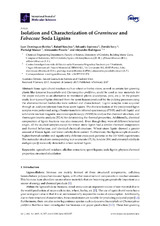Isolation and Characterization of Gramineae and Fabaceae Soda Lignins
Autor
Domínguez-Robles, J.
Espinosa, E.
Sánchez Serrano, Rafael
Davide, Savy
Mazzei, Pierluigi
Piccolo, Alessandro
Rodríguez, A.
Editor
MDPIFecha
2017Materia
Agricultural residuesAlkaline extraction
Spent liquors
Soda lignin
Physico-chemical properties
Structural elucidation
METS:
Mostrar el registro METSPREMIS:
Mostrar el registro PREMISMetadatos
Mostrar el registro completo del ítemResumen
Some agricultural residues such as wheat or barley straw, as well as certain fast-growing
plants like Leucaena leucocephala and Chamaecytisus proliferus, could be used as raw materials for
the paper industry as an alternative to traditional plants (eucalyptus, pine, etc.). In the present
study, four types of lignin obtained from the spent liquors produced by the pulping processes using
the abovementioned feedstocks were isolated and characterized. Lignin samples were acquired
through an acid precipitation from these spent liquors. The characterization of the precipitated lignin
samples were performed using a Fourier transform infrared spectroscopy (FT-IR) and both liquid- and
solid-state nuclear magnetic resonance spectroscopy (NMR) to analyse the chemical structure, and
thermogravimetric analysis (TGA) for determining the thermal properties. Additionally, chemical
composition of lignin fractions was also measured. Even though they were of different botanical
origin, all the studied samples except for wheat straw lignin had a similar chemical composition
and thermal behaviour, and identical chemical structure. Wheat straw lignin showed a greater
amount of Klason lignin and lower carbohydrate content. Furthermore, this lignin sample showed a
higher thermal stability and significantly different cross-peak patterns in the 2D-NMR experiments.
The molecular structures corresponding to p-coumarate (PCA), ferulate (FA) and cinnamyl aldehyde
end-groups (J) were only detected in wheat isolated lignin

